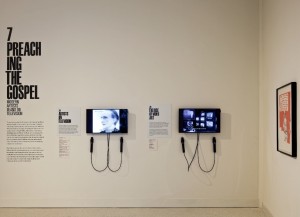
Modern Artists in and on Television
The prominence given by the networks to modernist aesthetics and avant-garde art was meant in part to counter a negative view of mass culture that was common in the period. Works by American writers of the 1950s—including David Riesman’s The Lonely Crowd, C. Wright Mills’s White Collar: The American Middle Classes, and William H. Whyte, Jr.’s The Organization Man—collectively argued that workers were little more than cogs in vast corporate bureaucracies, their leisure time shaped by a consumerist culture indifferent to human and aesthetic values. Television, in this narrative, was a tool of complacency, shallow and conventional.
Rejecting this perspective, some members of the industry believed that the relationship between art and television could be symbiotic, each serving the other. Discussions about art made television look serious and thoughtful; the new medium in turn served as an authoritative and accessible space in which discussions about art could reach a large audience, and challenging ideas could be disseminated.
(Above) installation view, Revolution of the Eye, NSU Art Museum Fort Lauderdale, October 2015. Courtesy of the NSU Art Museum